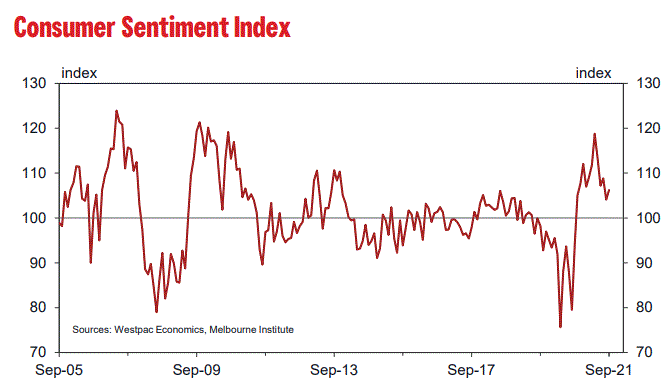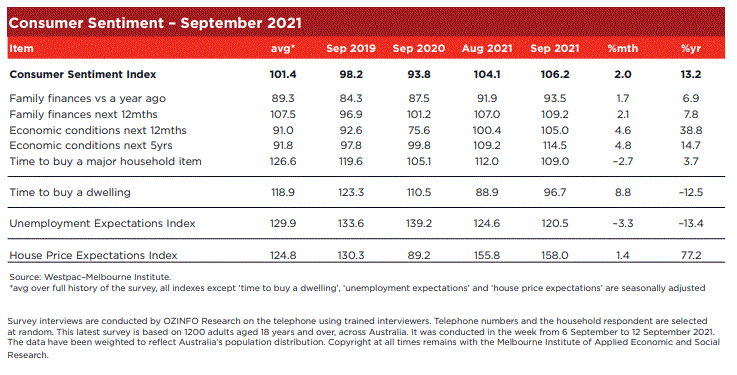Westpac monthly consumer sentiment:

The resilience of consumer sentiment in a period when Australia’s two major cities have been locked down and the economy has been contracting is truly remarkable. The Index is still comfortably above the reads seen over the five years prior to the pandemic and is only 0.9% below its June print just prior to Sydney’s move into lock-down.
Indeed, the latest month has seen confidence in NSW lift 5.3% to 106.4 while confidence in Victoria held steady at 104.1 despite the state moving back into another extended lock-down since early August. Reads above 100 mean optimists comfortably exceed pessimists in both states.
Sentiment also posted a strong 8.4% gain to 111.6 in Queensland, after the state moved out of its most recent lock-down in late August.
The improving vaccine situation appears to be a key factor behind these results.
Confidence amongst the 57% of respondents that have had at least one vaccine dose is running at 103.7 while confidence amongst the 27% that are unvaccinated but willing to get the jab is running at a remarkable 121.6.
That strongly suggests recent announcements of the lift in supply of Pfizer and Moderna vaccines and the roll-out to younger age-groups have been big positives.
Contrast this with the remaining 16% of respondents who are either unwilling to be vaccinated or undecided – sentiment across these groups is lagging badly at around 90. This is also the only segment that has pessimists outnumbering optimists.
The age-group breakdown also points to a ‘vaccine availability’ theme. Sentiment posted the strongest gains in the younger age-groups now in line to receive doses, surging 12.1% to 113.3 across the 18–24 year age group, and lifting 6.3% to 119 across the 25–34 year age group.
The clear theme from this survey is that consumers are looking through current lockdown disruptions to a sustained improvement once vaccinations reach levels that allow for a reopening. This contrasts starkly with a year ago when Victoria was stuck in an extended lock down while other states feared similar outbreaks signalling no real prospects for a sustained\ return to normality. In August last year the national Index stood at 79.5 even though only Victoria was in lock down at the time.
The latest monthly gain was led by components of the Index that track consumer expectations for the economy.
The ‘economic conditions, next 12 months’ sub-index increased by 4.6% while the ‘economic conditions, next 5 years’ sub-index was up by 4.8% – both indexes in solidly optimistic territory well above long run averages.
Views on family finance posted smaller gains, the ‘finances, next 12 months’ sub-index up by 2.1% and the ‘finances vs a year ago’ sub-index up by 1.7%.
The only component to record a decline in September was the ‘time to buy a major household item’ sub-index which fell 2.7% to a relatively subdued 109, well below the long run average of 126.6. Some of this could represent an element of ‘saturation’ with spending on durables having surged nearly 15% since the onset of the COVID pandemic.
Consumer expectations around the labour market also improved. The Westpac Melbourne Institute Index of Unemployment Expectations fell by 3.3% (recall that a fall in the Index means more respondents expect unemployment to fall in the year ahead). The Index is now only 7% higher than the average of the first six months of this year when the labour market was improving rapidly.
Notably, all of this came from improving confidence amongst females. Unemployment expectations across this group posted a 7% fall. This is a particularly encouraging result given that lock downs have disproportionately affected women, due to the heavy disruptions to service industries and school closures.
The shift is another example of the optimistic theme running through much of the survey detail.
There was a rebound in confidence in the housing market.
The ‘time to buy a dwelling’ index lifted 8.8%, recovering all of the decline we saw last month. However, the Index is still 26.8% below its November peak and around the lows we have seen in previous cycles since the Global Financial Crisis.
The message that deteriorating affordability is weighing on the housing market still holds. This shows through in the state detail with buyer sentiment in the most ‘affordability-constrained’ states showing outright pessimism – NSW at 94 and Victoria at 87.3 – but in optimistic territory in Queensland (105.3) and Western Australia (118.8).
Consumers remain bullish on the outlook for house prices.
Optimism was barely dented by the virus disruptions in recent months. The Westpac Melbourne Institute Index of House Price Expectations lifted 1.4% to remain near an eight year high at 158. This resilience is particularly evident in NSW, with the state index surging 5.7% to 161.
The picture continues to point to a rebalancing in markets as investors are encouraged by rising prices and the prospect of capital gains while owner occupiers respond to deteriorating affordability.
Every quarter we ask additional questions about where consumers see the ‘wisest place for savings’.
‘Safe’ options continued to dominate in September with just over half of respondents nominating ‘deposits’ or ‘pay down debt’ as their preferred options. Where consumers were a little more open to risk, they are about evenly split on ‘real estate’ and shares with just over 10% nominating each of these options – both lukewarm responses compared to boom times in the past which have seen well over a third of consumers picking these asset classes.
This caution amongst savers towards real estate does not conflict with the expectation that investors will play an increasingly more prominent role in the housing market.
Investors typically use significant leverage rather than allocating savings to their real estate purchases.
The Reserve Bank Board next meets on October 5. At the September meeting the Board decided to defer the next review of the bond purchase program to the February meeting, rather than November.
It therefore seems highly unlikely that there will be any policy changes before the February Board meeting. With the US Federal Reserve likely to have begun its tapering program by then and the economy likely to be bouncing back as high vaccination levels see easing restrictions, we expect the Board to further taper its bond purchases in February.


